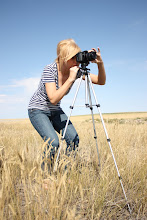Modifying Natural Light
One size fits all:
It may be a good idea to find filters that fit all lenses... that way you don't have to worry about getting a filter for each lens.
Polarizing Filters:
These filters create "greater color saturation by reducing or elimintating reflected glare" when you are shooting plants, flowers, and water. (be careful when using this filter with a wide-angle lens because the form of the lens will distort the overall coloring will using a polarizing filter.)
Split Neutral Density Filters:
So these filters are great! The book explains they are a "photographer's best friend." This filter is half clear, half darker gray so that you can, for example, darken a light sky to get the proper exposure of the land in your photograph.
Graduated Neutral Density Filters:
This is like the split neutal density filter except that sometimes, when you have a landscape where the sky and the land is not split 50/50 and you may have some trees, plants, or other objects that are more in the sky part than the land, and with a split neutral density those objects would be under exposed, or completely blacked out, therefore, the graduated neutral density filter gradually gets darker to try and avoid that.
Standard ND Filters:
These are used most often for "blurred motion" photos. It decreases the light that is captured with a very low shutter speed that is needed to blur a photo.
Color Modifiers:
These type of filters are your "color-enhancing and warming filters" to assist a photographer in the look they are going for in a photograph.
Blue/Gold Polarizing Filters:
These are used for "sunny days" to "reduce flare, bump up color saturation on land and water, and boost density and chroma of the blue sky."
Portable Reflector:
Dave brought a couple of these to class. These are round, flexible reflectors that reflect light and give you a certain look, whether it is more warming tones, cooling tones... ect.
Fill-in Flash:
Fill-in flashes are used as extra light that you may need, along with natural light, during photographing.
Designing the Picture Space
Dominance:
This section talks about the focus of compositions. In a more basic compostion, you may have on dominant feature that you are basing your photograph around. In more complex compositions, you may find dominane in more than one object. Focusing on those dominant features to create create your breathtaking photographs is a good skill to learn.
Color:
I think that a photographer's taste in the way that they choose to present color in a photograph varies between different photographers. However, the colors in a photograph are what tend to obtain the emotion, awe, and relation for people when looking at photography. Bright, brilliant photos with colors that catch the eye and are luminate in the composition create a masterpiece.
The Center of Interest:
Part of being a photographer is having the creative eye to find a focus or an element that you are wanting to shine in a photograph. When trying to place the center of interest, the center is always a good idea because that is where the eye tends to lead to. There is also the rule of thirds. This is when the "center of interst is to be placed one-third of the way from the top or bottom of the frame and one-third of the way from either side."

No comments:
Post a Comment